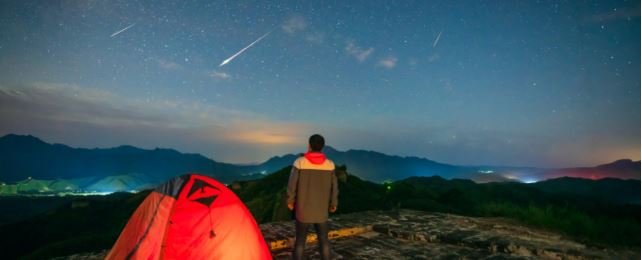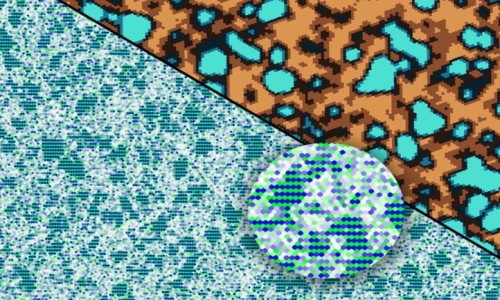


 11:56:8
11:56:8  2025-08-11
2025-08-11  1021
1021

Don't let the brilliant Moon deter you from enjoying the best meteor shower of the year: the 2025 Perseids.
It's that time of year once again. August sees warm nights, with late summer campers out awaiting that 'Old Faithful' of annual meteor showers: the August Perseids.
While 2025 also sees the shower peaking right around Full Moon; with a little bit of planning and patience, you can still catch this shower at its best.
On a 133-year orbit, Comet Swift-Tuttle last reached perihelion on December 12th, 1992, when rates for the Perseids picked up. Swift-Tuttle won't visit the inner solar system again until 2126.
Now, for the bad news: the (-90%) illuminated, waning gibbous Moon sits nearby in Pisces around the 12th, just 3 days after full on August 9th.
This will cut down on the number of faint meteors, though don't let it deter you in your meteor shower quest.
Perseid Prospects for 2025
The radiant rises to the northeast around local midnight. The peak for 2025 is expected to occur right around August 12th at 03:00 Universal Time (UT), favoring northern Europe at sunrise. North America rotates into the stream about 4-6 hours later.
Expect rates topping 50-100 per hour to pick up towards local sunrise, as your viewing site turns into the stream. Think of a car (the Earth) speeding down the highway; the forward windshield gets the bugs (the meteors).
You'll know if you saw a Perseid, if you can trace the path of the meteor back to the shower's radiant point along the Perseus-Cassiopeia border.
Be sure to check out the planetary parade on meteor dawn patrol, with Mercury low to the east, Saturn high to the south, and a very close together Jupiter and Venus on the morning of the 12th.
The source of the shower is periodic comet 109P/Swift-Tuttle. Discovered by astronomers Lewis Swift and Horace Tuttle in July 1862, records of apparitions for the comet go all the way back to Chinese observations in 322 BCE. The comet was notable as the first linked to an annual meteor shower.
Observing the 2025 Perseids
Meteor shower watching is actually pretty low tech. All you really need to enjoy the Perseids is a sturdy lawn chair, a hot beverage, and patience. A friend can help scan the sky, as Perseids can appear in any direction from the radiant.
You can beat the Moon by selecting your observing site beforehand to place its glare behind a nearby hill or building.
The Perseids often produce a twin peak spaced a few hours apart worldwide, so it's always worth watching on nights leading up to and after the expected maximum.
The Perseids are also a prodigious producer of fireballs, which can briefly light up the scene with surprising brilliance, leaving a persistent smoke train. I once saw a Perseid while watching from northern Maine that had an audible hiss.
We now know that you can ‘hear’ meteors via a localized phenomenon known as 'electrophonic sound'. Tune an FM radio to an unused frequency, and you may just hear meteor ‘pings’ among the static.
Clouded out? You can still catch the Perseids live on August 12th starting at 21:00 UT/ 17:00 EDT, courtesy of Astronomer Gianluca Masi and the Virtual Telescope Project.
Reality Of Islam |
|

By applying

Stanford, C

A new study

Researchers
 9:3:43
9:3:43
 2018-11-05
2018-11-05
10 benefits of Marriage in Islam
 7:5:22
7:5:22
 2019-04-08
2019-04-08
benefits of reciting surat yunus, hud &
 9:45:7
9:45:7
 2018-12-24
2018-12-24
advantages & disadvantages of divorce
 11:35:12
11:35:12
 2018-06-10
2018-06-10
 6:0:51
6:0:51
 2018-10-16
2018-10-16
 7:26:19
7:26:19
 2022-04-08
2022-04-08
 3:18:29
3:18:29
 2022-12-24
2022-12-24
 11:34:48
11:34:48
 2022-06-29
2022-06-29
 11:2:27
11:2:27
 2022-10-06
2022-10-06
 2:33:4
2:33:4
 2023-02-15
2023-02-15
 3:42:22
3:42:22
 2021-12-24
2021-12-24
 7:0:55
7:0:55
 2022-05-17
2022-05-17
 5:41:46
5:41:46
 2023-03-18
2023-03-18
| LATEST |